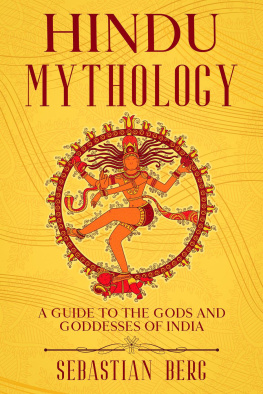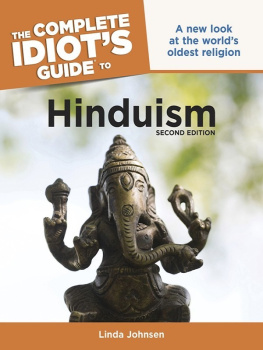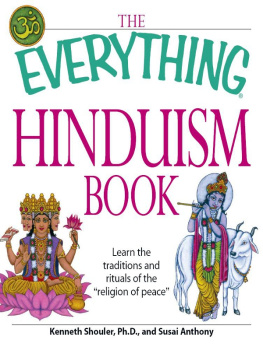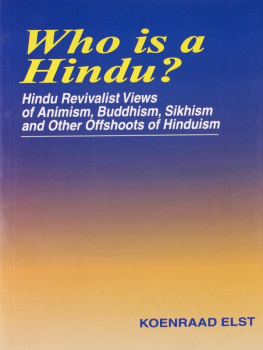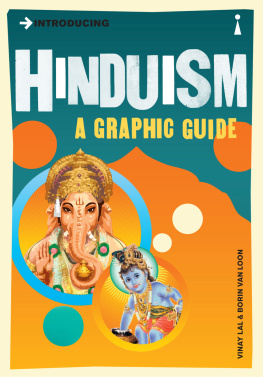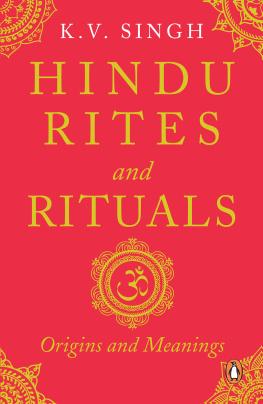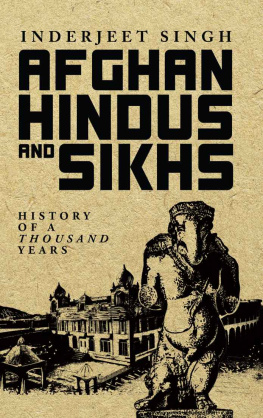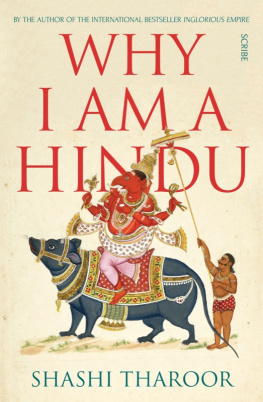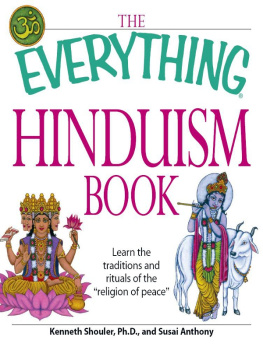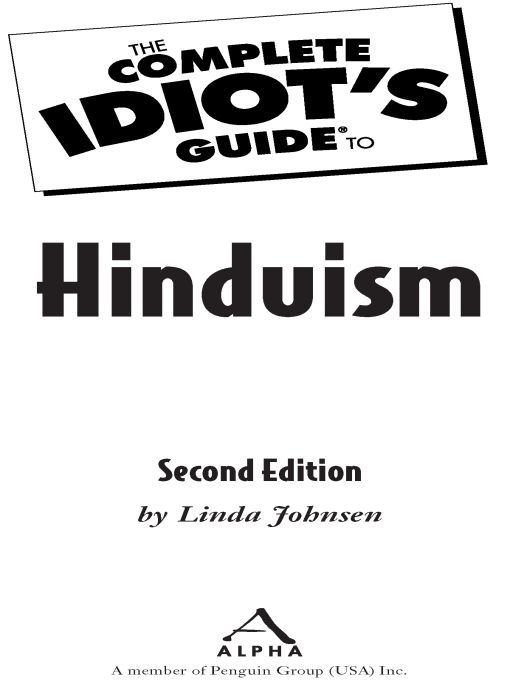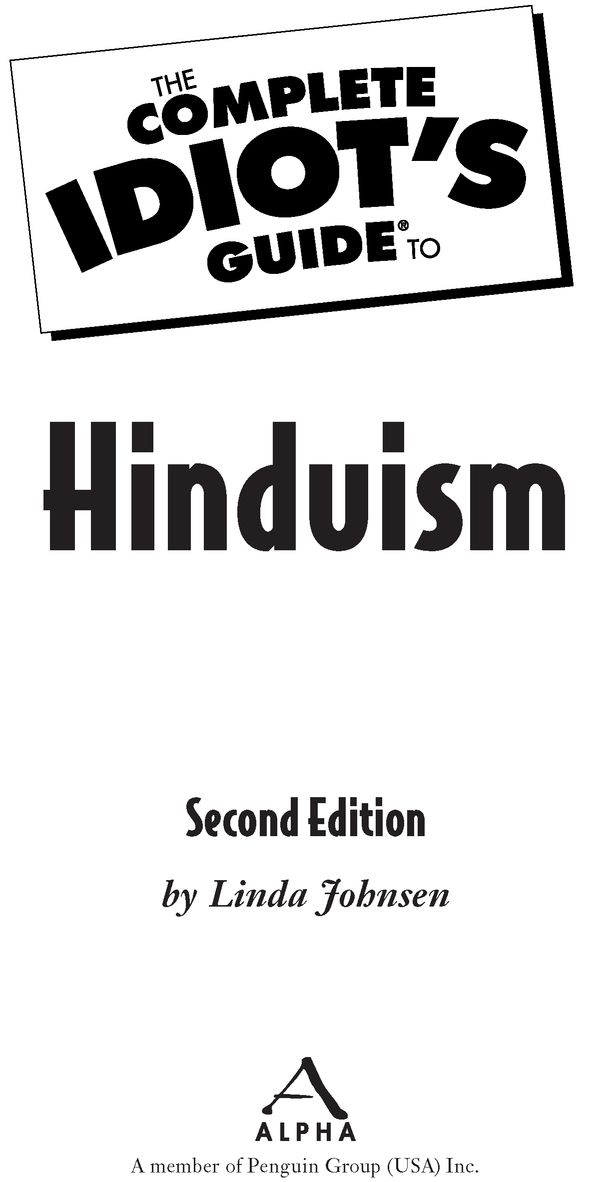Table of Contents
To Hindus everywhere, with affection and respect.
Foreword
The Hindu religion is an ocean of spiritual teachings about all aspects of life and consciousness. Its the worlds oldest religion, going back to the very dawn of history. It sees its origin in the cosmic mind itself. Yet Hinduism is perhaps the worlds youngest religion because it emphasizes the authority of living teachers and allows for correction and evolution over time.
Hinduism is the most diverse religious tradition in the world. It could be said that there are probably more religions inside of Hinduism than outside of it. It has numerous saints, sages, and yogis, both male and female, from ancient to modern times, and today still has what is probably the largest number of monks and renunciates (including a number of Westerners). Tens of millions of Hindus showed up in Allahabad for the Kumbha Mela festival in January 2001. It was the largest gathering of any type and the largest religious gathering in the history of the world.
Hinduism is the worlds largest non-biblical tradition, with nearly a billion followers worldwide. It could be called the worlds largest non-organized religion as it emphasizes individual spiritual experience, the realization of the higher Self over any religious institution, book, dogma, or savior. Its also the worlds largest native or pagan tradition, reflecting the ancient spiritual traditions that once existed all over the world. Like native traditions everywhere, it honors God or the sacred throughout all of nature. It has many insights in harmony with the ecological age, as it affords reverence to the Earth as a conscious and loving presence and asks us to respect our environment.
Hinduism contains the worlds oldest and largest tradition of Goddess worshipworshipping the Divine not only as father but also as mother. It recognizes all the diverse forms of the Goddess and her powers of wisdom, beauty, strength, love, and compassion.
Perhaps most notably, Hinduism is the worlds largest pluralistic tradition, recognizing One Truthan eternal reality of Being-Consciousness Bliss in all beingsbut also many paths to realize it. Hinduism recognizes theism (the belief in One Creator) but only as one portion of the human religious experience that includes polytheism, pantheism, monism, and even atheism. As the most inclusive of the worlds great religions, Hinduism has room for all these views and yet guides us through these to Self-realization that transcends them all.
Hinduism has probably the worlds oldest and largest literature of spirituality, mysticism, and yoga. It provides a complete spiritual culture including art, dance, sculpture, medicine, and science, with all these subjects explained according to a science of consciousness.
Hinduism has a view of the universe in time and space that is compatible with modern science. Aspects of the Hindu tradition such as Yoga, Vedanta, Ayurveda, and Vedic astrology are already popular in the West. Hindu terms such as guru, mantra, shakti, prana, kundalini, and chakra have entered into the English language. Great gurus from the Hindu tradition such as Ramana Maharshi, Yogananda, Ramakrishna, Shivananda, Aurobindo, and Mahatma Gandhi have extensive followings and much respect in the West today.
There are now nearly two million Hindus of Indian origin in the United States, as well as significant numbers in Canada, the United Kingdom, and the Caribbean, with Hindu temples in most of the main cities of the United States. This Hindu group is one of the wealthiest and best-educated in the West and contains many successful scientists, computer engineers, and doctors. India itself, the home of most Hindus, is the second largest country in the world and is expected to be a major superpower in the coming century.
The New Age Movement in the West honors Hindu gurus and teachings. Most New Age followers believe in a higher Self, God as both Father and Mother, karma and rebirth, and spiritual practices such as Yoga, much like the Hindu religion.
Clearly examining Hinduism will geometrically expand your ideas of religion and spirituality. The Complete Idiots Guide to Hinduism, Second Edition, is the best place to begin such an adventure in consciousness. Linda Johnsenherself a practitioner in the traditiondoes a superb job of making this very different religion relevant, understandable, and appealing to the modern mind. Her book is remarkably refreshing and dynamic, showing the living beauty and profundity of this great spiritual tradition. It makes an excellent, engaging textbook for teaching Hinduism.
As one who has traveled throughout the world, including all over India, teaching aspects of the Hindu tradition to both Hindus and Westerners, I can attest that Johnsens book is probably the best introduction and overview of the Hindu religion available in English today. The book is written with humor, love, consciousness, and inspiration. It shows the Hindu religion alive and expressive today, so that we can easily access it in our own life-experience. I doubt that a single serious reader will come away without finding his view of Hinduism challenged, expanded, and transformedand along with it his view of the entire universe, humanity, and all of history.
Dr. David Frawley (Pandit Vamadeva Shastri)
Author, Yoga and Ayurveda, Hinduism, the Eternal Tradition; Director, American Institute of Vedic Studies
Introduction
Many of us in the West think of India as a poor and backward country. We forget that for at least 4,000 years the Hindus were recognized (and envied) as some of the richest, best-educated, most scientifically advanced, and most profoundly religious people on the planet. History shows that Hinduism has provided the spiritual foundation for one of the most successful and enduring cultures in the world.
The Sumerians dominated the Middle East in the third millennium B.C.E. At one time, they were believed to be the founders of civilization. Today we know they imported goods by the ton from equally civilized trading partners in India. They even adopted the system of weights and measures used by the Hindus. The Sumerians most famous myth is the amazing tale of a flood that wiped out almost all life on Earth. This same story is found in Indias earliest scriptures and may date as far back as 4000 B.C.E.
Manetho, the Egyptian priest who wrote a history of his country in the third century B.C.E., counts the immigration of a colony of Hindus to Egypt around 1400 B.C.E. as one of the most significant events in Egyptian history. Apollonius of Tyana, a traveler from Turkey who visited both India and Egypt during the time of Christ, noted the amazing similarities between the Egyptian desert ascetics and the Hindu mystics. He was convinced that Hindu immigrants centuries earlier had trained the Egyptians.
Alexander the Great, during his brief military foray into India, was fascinated by the Hindu holy men. His troops brought home incredible stories about the wisdom and incorruptibility of these Indian sages.
A major problem in the Roman Empire from the time of Caesar Augustus through Emperor Hadrian was Romes massive trade imbalance with India. It brought Rome to the verge of an economic meltdown! Hindu philosophers were teaching in Rome by the third century C.E. at the latest. Some scholars believe they profoundly influenced Neoplatonic thinkers like Plotinus (who tried to get to India) and, through them, the Western and Kabbalistic mystical systems.




